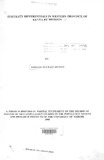| dc.description.abstract | The main objective of the study was to find out factors that have contributed to
persistently high fertility in Western province. The study was based on the 1989 census
results. The study also looked at fertility in relation to socio-economic, Cultural and
demographic factors. Fertility differentials by the afore mentioned factors was examined at
provincial, district and divisional levels.
The method of data analysis was Coale and Trussel P/F ratio technique was applied
to estimate fertility levels in this study.
The study's finding revealed that the level of fertility in the province is on the decline.
This is when compared to 1979 census results. The estimation of total fertility rate by
divisions revealed that rates ranged between six and seven children per woman. At district
and divisional level, the rates depicted a uniform pattern albeit slight differences.
The findings also revealed that women with secondary level of education registered
lower fertility compared to those with primary level,and those with no education level.
However ,women with no education registered high fertility rates than those with primary
level of education.
The study also found out that women who use treated,clean water (piped) registered
low rates of fertility.
Employed women (wage earners) had lower rates than unemployed and non wage
earners. The reason could be that the employed women are able to purchase birth control
devices.
According to the findings, women residing in urban centres recorded lower fertility
rates than those in rural areas. This is because they benefited from urban based facilities
which are inadequate in rural areas.
The women in monogamous unions recorded higher fertility rates than those in
polygymous unions although the difference was minimal. The reason attributed to this could
be due to the sleeping arrangements associated with both unions. While in a monogamous
union the husband is constantly with his one wife, therefore higher chance to conceive, in
polygymous union, he has more than one wife.
On ethnicity, the three main communities in the province namely the Luhya, the Teso
and the Kalenjin registered almost the same fertility rates. This could be attributed to shared
beliefs and customs that are related to reproduction. The slight differences could be as a
result of distinct behaviours of each particular group.
Married women registered higher fertility rates than the single, separated, divorced
and widowered categories.
The study recommends that both physical and social infrastructure to be distributed
equally in both rural and urban areas so as to reduce the gap between the two regions.
Amenities such as schools, hospitals, piped water, e.t.c., if properly distributed would have
an impact on fertility levels in the province. Employment and education opportunities should
be made more available for both males and females as they are likely to have great influence
on fertility levels. | |

